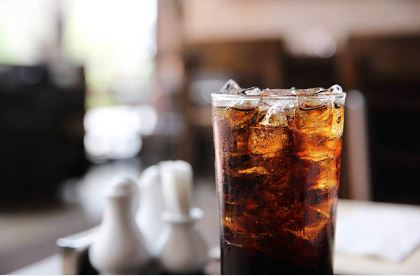
Background
Water for drinking not only as a substitute for lost body fluids and mineral supply, but also for enjoyment and give a fresh taste as thirst-quenching.
Tastes of society towards a fresh drink has been taken into consideration for the beverage company.
History
Coca-Cola history began in 1886 when the curiosity of an Atlanta pharmacist, Dr. John S. Pemberton, led him to create a distinctive tasting soft drink that could be sold at soda fountains.
He created a flavored syrup, took it to his neighborhood pharmacy, where it was mixed with carbonated water and deemed “excellent” by those who sampled it.
Dr. Pemberton’s partner and bookkeeper, Frank M. Robinson, is credited with naming the beverage “Coca‑Cola” as well as designing the trademarked, distinct script, still used today.
Carbonated Drink
Soft drinks (soft drink) is a beverage that does not contain alcohol, a beverage in the form of powder or liquid containing foodstuffs and other additional materials both natural and synthetic, is packed in containers ready for consumption.
Soft drinks consisted of two types, namely:
- Carbonated soft drinks
- Soft drinks without carbonation.
Raw Material
Water
Water is the largest content in carbonated soft drinks.
The water used must have a high quality, namely: a clear, odorless, colorless, free from organisms that live in water, alkalinity <50 ppm of total dissolved solids <500 ppm, and the content of iron and manganese <0.1 ppm.
Concentrate
Concentrate is the essence/content/main part of a material/substance. For example: fruit juice concentrate, protein concentrate, whey concentrate and others.
Concentrates are used as raw materials or auxiliary materials in the manufacture of beverages.
Sweetener
Besides sugar as a sweetener and enhancer calories, also an influence on the appearance of beverages as well as a carrier of flavor components so that uniformly dispersed in the beverage, while commonly used artificial sweeteners are saccharin and sodium, calcium, magnesium, and potassium cyclamate.
Acid Taste
Aiming to give a sour taste in carbonated drinks, modifying the sweetness of sugar, acts as a preservative, and can accelerate the inversion of sugar in the syrup/drink.
Acidulant used in the beverage must be of the edible acid (edible/food grade) include citric acid, phosphate acid, malic acid, fumaric acid, tantrat acid, adipic acid, and others.
Giving Aroma
Giving aromas prepared by industry with regard to the drinks industry with a special formula, sometimes has been coupled with the acid and dyes.
Carbon dioxide (CO₂)
Carbonation produce ie 'hiss' which reinforces the freshness of flavor and 'sparkle' and 'bubble' when the beverage is poured from the container.
Additional ingredients
In addition to the main raw material is also soft drinks also contain preservatives (additives).
Industrial Process
Water Treatment
Water is the main ingredient for the manufacture of carbonated beverages. There are stages in light manufacture.
The Process Of Making Syrup
Water that has undergone a process of purification is mixed with sugar while stirring and heated to obtain a simple syrup drink.
Mixing Process
This process is done by mixing the water and the syrup is done in accordance with the beverage raw material that has been set.
CO₂ Purification
In the process of carbonation, CO₂ would need to be purified mixed beforehand. In the process chemicals such as potassium permanganate can be used, as well as activated charcoal.
In the process of carbonation, CO₂ would need to be purified mixed beforehand. In the process chemicals such as potassium permanganate can be used, as well as activated charcoal.
Preparation of Syrup
At CSD-making process, the syrup is an important component in delivering taste, color and flavor to the drink.
Bottle Washing Process
Before filled with CSD, bottles should be washed beforehand so that product quality will be maintained.
In the process of washing the bottle will go through several stages: Pre-inspection stage where bottles are sorted and checked for feasibility physically by the inspector.
Filling Process
Packaging Bottled: Bottles that have escaped from the EBI will be heading filler machine which has 97 filling valve and capable of producing 800 bottles per minute.
Packaging Cans: Cans used in packaging the CSD is sized 250 ml and 330 ml. Empty cans arranged above paletpalet.
Type Of Waste
Solid waste is usually a bottles glass, cans, cardboard, crown and sugar bags.
Bottles usually come from broken bottles and bottles during the production process which can not be used again for packing produce carbonate soft drink (CSD).
Waste gas: Waste gas coming from the boiler, washer, forklifts, and vehicles.
To minimize waste generated gas can be done by taking care of forklifts, boilers and vehicles well, so that combustion occurs perfectly.
Waste Treatment
Waste is the result of an activity by man that are not used anymore in these activities.
Poor waste treatment may result in environmental pollution, therefore the need for proper waste management so that waste generated does not damage the environment.
Type of Waste
Liquid waste: Liquid waste originating from the production process, bottle washing process, residual chemicals testing and good sanitation production space and equipment.
Conlusion
The main process is the carbonate beverage manufacturing:
a. Water treatment processes (water treatment):
- Raw water
- Treated water
- Soft treated water
- The water Softener
- General use of water
b. Processing of syrup (syrup manufacturing) :
- Making simple syrup
- Making the finish syrup
c. Carbon dioxide purification process (CO₂)
d. Mixing (mixer/Carbon cooler)
e. Bottle washing process
f. The process of filling (filling)
*Sumber : Kevin Septioga
Baca Juga :